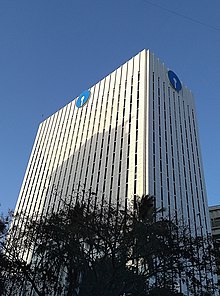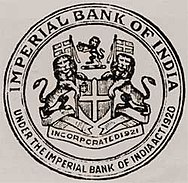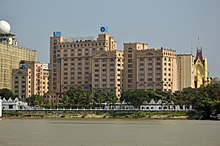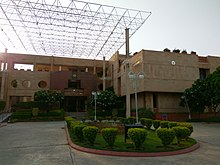-
SBI FL Gomes Road Branch, Vasco da Gama, Goa
-
SBI Rura Branch, Rura, Uttar Pradesh
-
SBI Hudkeshwar Branch, Nagpur, Maharastra
 | |
 State Bank Bhavan, Nariman Point, Mumbai | |
| Company type | Public |
|---|---|
| |
| ISIN | INE062A01020 |
| Industry | Banking, financial services |
| Predecessor | Imperial Bank of India (1921 – 1955)
|
| Founded | 1 July 1955 State Bank of India
|
| Headquarters | State Bank Bhawan, M.C. Road, Nariman Point, Mumbai, Maharashtra, India |
Number of locations | India: 22,219 Branches 62,617 ATMs International: 229 Branches in 31 countries |
Area served | Worldwide |
Key people |
|
| Products | |
| Revenue | |
| Total assets | |
| Total equity | |
| Members | 48 crores+ [4] |
Number of employees | 2,32,296 (31 March 2024)[5] |
| Parent | Ministry of Finance (Government of India (57.5%)) |
| Subsidiaries |
|
| Capital ratio | Tier 1 11.03% (2022)[6] |
| Rating | |
| Website | sbi.co.in bank.sbi |
| Footnotes / references [3][8][9][10] | |
State Bank of India (SBI) is an Indian multinational public sector bank and financial services statutory body headquartered in Mumbai, Maharashtra. SBI is the 47th largest bank in the world by total assets and ranked 221st in the Fortune Global 500 list of the world's biggest corporations of 2020, being the only Indian bank on the list.[11] It is a public sector bank and the largest bank in India[12] with a 23% market share by assets and a 25% share of the total loan and deposits market.[13] It is also the tenth largest employer in India with nearly 250,000 employees.[14][15][16] In 2023, the company’s seat in Forbes Global 2000 was 77.[17]
On 14 September 2022, State Bank of India became the third lender (after HDFC Bank and ICICI Bank) and seventh Indian company to cross the ₹5 lakh crore market capitalisation on the Indian stock exchanges for the first time.[18] The largest public lender in the country reached a milestone on April , 2024, when its market capitalisation surpassed ₹7 lakh crore, making it the second public sector undertaking (PSU) to do so, after Life Insurance Corporation.[19] The Reserve Bank of India (RBI) has identified the SBI, HDFC Bank, and ICICI Bank as Domestic Systemically Important Banks (D-SIBs), which are often referred to as banks that are “too big to fail”.[20][21]
The bank descends from the Bank of Calcutta, founded in 1806 via the Imperial Bank of India, making it the oldest commercial bank in the Indian subcontinent. The Bank of Madras merged into the other two presidency banks in British India, the Bank of Calcutta and the Bank of Bombay, to form the Imperial Bank of India, which in turn became the State Bank of India in 1955.[22] Overall the bank has been formed from the merger and acquisition of more than twenty banks over the course of its 200-year history.[23][24] The Government of India took control of the Imperial Bank of India in 1955, with Reserve Bank of India (India's central bank) taking a 60% stake, renaming it State Bank of India.
On 16 August 2022, in an attempt to facilitate and support India's start-ups, SBI announced the launch of its first "state-of-the-art" dedicated branch for start-ups in Bengaluru.[25]



The roots of the State Bank of India lie in the first decade of the 19th century when the Bank of Calcutta (later renamed the Bank of Bengal) was established on 2 June 1806. The Bank of Bengal was one of three Presidency banks, the other two being the Bank of Bombay (incorporated on 15 April 1840) and the Bank of Madras (incorporated on 1 July 1843). All three Presidency banks were incorporated as joint stock companies and were the result of royal charters. These three banks received the exclusive right to issue paper currency till 1861 when, with the Paper Currency Act, the right was taken over by the Government of India. The Presidency banks amalgamated on 27 January 1921, and the re-organised banking entity took as its name Imperial Bank of India. The Imperial Bank of India remained a joint-stock company but without Government participation.
Under the provisions of the State Bank of India Act of 1955, the Reserve Bank of India, which is India's central bank, acquired a controlling interest in the Imperial Bank of India. On 1 July 1955, the Imperial Bank of India became the State Bank of India. In 2008, the Government of India acquired the Reserve Bank of India's stake in SBI to remove any conflict of interest because the RBI is the country's banking regulatory authority.
In 1959, the government passed the State Bank of India (Subsidiary Banks) Act. This made eight banks that had belonged to princely states into subsidiaries of SBI. This was at the time of the First Five-Year Plan, which prioritised the development of rural India. The government integrated these banks into the State Bank of India system to expand its rural outreach. In 1963 SBI merged the State Bank of Jaipur (est. 1943) and State Bank of Bikaner (est.1944).
SBI has acquired local banks in rescues. The first was the Bank of Bihar (est. 1911), which SBI acquired in 1969, together with its 28 branches. The next year SBI acquired the National Bank of Lahore (est. 1942), which had 24 branches. Five years later, in 1975, SBI acquired Krishnaram Baldeo Bank, which had been established in 1916 in Gwalior State, under the patronage of Maharaja Madho Rao Scindia. The bank had been the Dukan Pichadi, a small moneylender, owned by the Maharaja. The new bank's first manager was Jall N. Broacha. In 1985, SBI acquired the Bank of Cochin in Kerala, which had 120 branches. SBI was the acquirer as its affiliate, the State Bank of Travancore, already had an extensive network in Kerala.

National Institute of Design, Ahmedabad designed the SBI logo in 1971.[26]
There was, even before it happened, a proposal to merge all the associate banks into SBI to create a single very large bank and streamline operations.[27]
The first step towards unification occurred on 13 August 2008 when State Bank of Saurashtra merged with SBI, reducing the number of associate state banks from seven to six. On 19 June 2009, the SBI board approved the absorption of State Bank of Indore, in which SBI held 98.3%. (Individuals who held the shares before their takeover by the government held the balance of 1.7%.)[28]
The acquisition of State Bank of Indore added 470 branches to SBI's existing network of branches. Also, following the acquisition, SBI's total assets approached ₹10 lakh crore. The total assets of SBI and the State Bank of Indore were ₹9.98 lakh crore as of March 2009. The process of merging of State Bank of Indore was completed by April 2010, and the SBIndore branches started functioning as SBI branches on 26 August 2010.[29]
On 7 October 2013, Arundhati Bhattacharya became the first woman to be appointed chairperson of the bank.[30] Mrs. Bhattacharya received an extension of two years of service to merge into SBI the five remaining associate banks.
In February 2024, State Bank of India began a partnership with Flywire Corporation to make student fees and compliance with the Reserve Bank of India’s Liberalised Remittance Scheme (LRS) more transparent.[31]
SBI provides a range of banking products through its network of branches in India and overseas, including products aimed at non-resident Indians (NRIs). Concerning domestic banking business, SBI has 17 regional hubs known as local head offices (LHOs), under whom are 57 administrative offices (AOs), that are located in important cities throughout India, under whom are furthermore administrative sub-offices known as regional business offices (RBOs), with each RBO having, under its direct administrative control, some 40 to 50 branches.

As per SBI Official website data, SBI has 22,405 branches in India.[32][33] In the financial year 2012–13, its revenue was ₹2.005 trillion (US$24 billion), 95.35% of which came from domestic operations. Similarly, domestic operations contributed to 88.37% of total profits for the same financial year.[32]
Under the Pradhan Mantri Jan Dhan Yojana of financial inclusion launched by Government in August 2014, SBI held 11,300 camps and opened over 30 lakh (3 million) accounts by September, which included 21 lakh (2.1 million) accounts in rural areas and 15.7 lakh (1.57 million) accounts in urban areas.[34]
As of 2014–15, the bank had 191 overseas offices spread over 36 countries having the largest presence in foreign markets among Indian banks.[35]
|
Main article: Nepal SBI Bank Limited |
In Nepal, SBI owns 55% of the share. (The state-owned Employees Provident Fund of Nepal owns 15% and the general public owns the remaining 30%.) Nepal SBI Bank Limited has branches throughout the country.
In Nigeria, SBI operates as INMB Bank. This bank began in 1981 as the Indo–Nigerian Merchant Bank and received permission in 2002 to commence retail banking. It now has five branches in Nigeria.
In Moscow, SBI owns 60% of Commercial Bank of India, with Canara Bank owning the rest. In Indonesia, it owns 76% of PT Bank Indo Monex. State Bank of India already has a branch in Shanghai and plans to open one in Tianjin.[44]
In Kenya, State Bank of India owns 76% of Giro Commercial Bank, which it acquired for US$8 million in October 2005.[45]
SBI South Korea In January 2016, SBI opened its first branch in Seoul, South Korea.
SBI South Africa
SBI UK Ltd[46]

SBI USA In 1982, the bank established a subsidiary, State Bank of India, which now has ten branches—nine branches in the state of California and one in Washington, D.C. The 10th branch was opened in Fremont, California on 28 March 2011. The other eight branches in California are located in Los Angeles, Artesia, San Jose, Canoga Park, Fresno, San Diego, Tustin and Bakersfield.

SBI acquired the control of seven banks in 1960. They were the seven regional banks of former Indian princely states. They were renamed, prefixing them with 'State Bank of'. These seven banks were State Bank of Bikaner and Jaipur (SBBJ), State Bank of Hyderabad (SBH), State Bank of Indore (SBN), State Bank of Mysore (SBM), State Bank of Patiala (SBP), State Bank of Saurashtra (SBS) and State Bank of Travancore (SBT). All these banks were given the same logo as the parent bank, SBI. State Bank of India and all its associate banks used the same blue Keyhole logo said to have been inspired by Ahmedabad's Kankaria Lake.[47] The State Bank of India wordmark usually had one standard typeface, but also utilised other typefaces. The wordmark now has the keyhole logo followed by "SBI".
The plans for making SBI a single very large bank by merging the associate banks started in 2008, and in September of the same year, SBS merged with SBI. The very next year, the State Bank of Indore (SBN) also merged.
Following a merger process,[48][49] the merger of the 5 remaining associate banks, (viz. State Bank of Bikaner and Jaipur, State Bank of Hyderabad, State Bank of Mysore, State Bank of Patiala, State Bank of Travancore); and the Bharatiya Mahila Bank) with the SBI was given an in-principle approval by the Union Cabinet on 15 June 2016.[50] This came a month after the SBI board had, on 17 May 2016, cleared a proposal to merge its five associate banks and Bharatiya Mahila Bank with itself.[51]
On 15 February 2017, the Union Cabinet approved the merger of five associate banks with SBI.[52] An analyst foresaw an initial negative impact as a result of different pension liability provisions and accounting policies for bad loans.[53][54] The merger went into effect from 1 April 2017.[55]

Apart from five of its associate banks (merged with SBI on 1 April 2017), SBI's non-banking subsidiaries include:
In March 2001, SBI (with 74% of the total capital), joined with BNP Paribas (with 26% of the remaining capital), to form a joint venture life insurance company named SBI Life Insurance Company Ltd.
As of July 2023, the SBI group had 65,627 ATMs.[56] Since November 2017, SBI also offers an integrated digital banking platform named YONO.
In March 2020, as part of an RBI-directed rescue deal, the State Bank of India acquired 48.2% of the shares of Yes Bank.[57] As of February 8, 2024, the shareholding has decreased to 26.13%.[58]

|
Main article: List of chairmen of the State Bank of India |
SBI is one of the largest employers in the world with 245,652 employees as of 31 March 2021. Out of the total workforce, the representation of women employees is nearly 26%. The percentage of Officers, Associates, and Subordinate staff was 44.28%, 41.03%, and 14.69% respectively on the same date. Each employee contributed a net profit of ₹828,350 (US$9,900) during FY 2020–21.[59]
State Bank of India maintains a philanthropic arm in the name of SBI Foundation which is involved to support development initiatives in India and also with initiatives that comply under the Ministry of Corporate Affairs under Corporate Social Responsibility. [66][67]